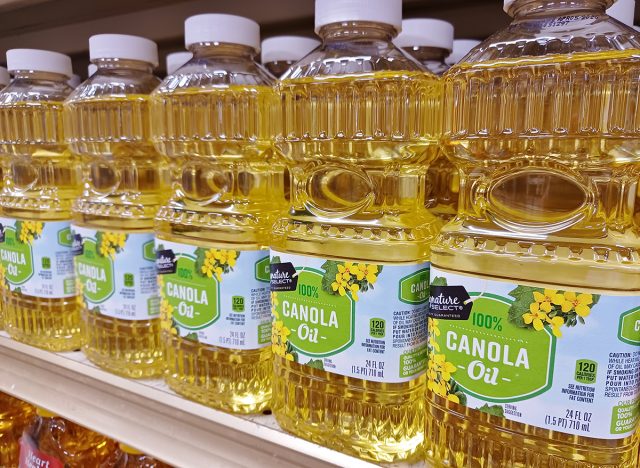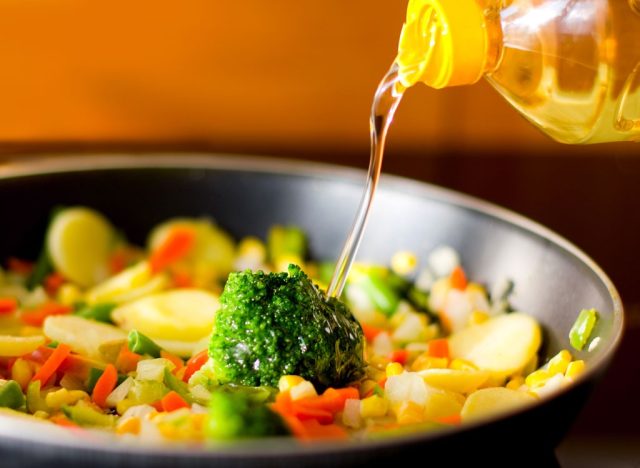Canola vs. Vegetable Oil: Is One Healthier?

Whether you're baking, roasting veggies, or pan-frying chicken, oil is a staple that you'll always need to have on hand. And if you're a recipe follower, you've probably noticed that canola or vegetable oil is often called for. They might look and smell nearly identical, but are they really that similar? And in the health debate of canola vs. vegetable oil, who wins?
Both canola and vegetable oils are go-to choices for everything from baking cookies to frying fish, but there are some important differences in how they're used, their nutrition, and their potential health effects. To help you confidently choose the right oil for your needs, we've broken down the key differences, their health benefits, and any considerations to keep in mind next time you're in the oil aisle.
Read on, then check out these 10 Highest-Quality Cooking Oils on Grocery Shelves.
How Canola and Vegetable Oil Are Made

One of the most obvious differences between canola and vegetable oil is where they come from and how they're produced.
Canola oil comes from the seeds of the canola plant, a plant that produces pretty yellow flowers and pods that are filled with oil-rich black seeds. Although canola plants were originally bred from rapeseed, a crop used for industrial oil, canola oil has its own distinct properties. To be classified as canola oil, it must contain less than 2% erucic acid—a fatty acid linked to potential heart issues. Heat and chemical solvents are generally used to extract the oil from the seeds, although you can find "cold-pressed" canola oil that does not use heat in processing.
Vegetable oil can be extracted from any type of seed or plant, and many oils are classified as vegetable oil, such as canola, soybean, avocado, olive, sunflower, and more. When you buy an oil labeled as "vegetable oil," it will most often include 100% soybean oil but may be combined with other plant oils. Oil is extracted from the soybeans with pressure, heat, and chemical solvents. It's then highly refined to remove any impurities before it's safe to eat.
Nutritional Comparison of Both Oils
Here's how the nutrition stats between canola vs. vegetable oil (soybean oil) stack up, according to the USDA Nutritional Food Database:
Canola Oil

Calories: 124
Total Fat: 14 g
Saturated Fat: 1 g
Monounsaturated Fat: 9 g
Polyunsaturated Fat: 4 g
Vegetable Oil

Calories: 120
Total Fat: 13.5 g
Saturated Fat: 2 g
Monounsaturated Fat: 3 g
Polyunsaturated Fat: 8 g
Health Benefits of Each Oil

While canola oil and vegetable oil have similar calories and total amounts of fat in each serving, you'll find that canola oil has a fatty acid profile that's more beneficial to heart health and may offer more cardiovascular protective benefits. Vegetable oil is still low in saturated fats, has some heart-protective properties, and includes antioxidant-rich vitamins and minerals that support bone health.
Canola Oil Benefits
Canola oil contains a mix of fats but is especially high in monounsaturated fat (9 grams per tablespoon). According to a 2022 review in Missouri Medicine, replacing saturated fats with monounsaturated fats is linked to better health outcomes, like reduced body fat, lower body weight, and improved insulin sensitivity.
While research on canola oil's specific effects on heart health and metabolism isn't entirely conclusive, a 2019 review in Advances in Nutrition found a small connection between canola oil and modest weight loss. However, other studies show mixed results in terms of clear benefits.
One tablespoon of canola oil provides 16% of your daily value of vitamin E, an antioxidant that helps protect your cells from oxidative stress caused by fat oxidation in the body.
Vegetable Oil Benefits
Vegetable oil, typically made from soybean oil, has a similar total fat content as canola oil but is higher in polyunsaturated fats (8 grams per tablespoon). This includes a small amount of ALA, an omega-3 fatty acid, and a larger portion of omega-6 fatty acids.
Despite past concerns that omega-6 fatty acids may be inflammatory, a 2022 review in Nutrition did not find clear evidence that omega-6 fats increase inflammation and oxidative stress. In fact, when used to replace saturated fats, omega-6s are linked to lower blood cholesterol levels. Soybean oil is also a good source of plant sterols, which may help reduce cholesterol levels even further.
One tablespoon of vegetable oil provides 21% of your daily value of vitamin K, a fat-soluble vitamin essential for blood clotting and bone health. Vitamin K not only helps with bone calcification but may also prevent calcification in unwanted places, like your arteries.
Are There Any Risks?

While both canola and vegetable oils can offer some health benefits when used in moderation, there are a few reasons you might want to limit how much you use in your cooking or choose in your store-bought foods.
Canola Oil Health Considerations
Like all fats, canola oil contributes 9 calories per gram, making it easy to eat more calories than your body needs if you're not mindful. While it may help lower cholesterol when replacing saturated fats, too much fat in your diet—canola oil included—can potentially contribute to weight gain, heart disease, and even some types of cancer.
Vegetable Oil Benefits Health Considerations
Even though research is shifting away from the idea that omega-6 fatty acids are inherently inflammatory, having too much of them compared to omega-3s might not be ideal. Balancing your intake of these fats by including more omega-3-rich foods can be a healthier approach.
Since vegetable oil (often made from soybeans) is highly refined, it's usually safe for people with soy allergies, as the refining process removes proteins. However, always check with your allergist to be sure. One thing to note is that phytoestrogens, compounds found in soybeans, can sometimes make their way into the oil. In large amounts, these might affect hormone levels. Animal studies suggest that excess soybean oil could indirectly increase testosterone, but how this applies to humans isn't fully clear yet.
Taste & Cooking Properties

Both canola oil and vegetable oil have a neutral flavor and can be used for a wide variety of cooking and baking without distracting from the other flavors used.
Cooking with Canola Oil
Since canola oil has a very light, neutral flavor, it can be used in everything from cookies and sweet breads to pan-frying fish or roasting vegetables. It's also a good option for things like marinades and dressings when you don't want the flavor of the oil to overpower the other ingredients
Cooking with Vegetable Oil
Vegetable oil also has a neutral taste, as the refining process removes most of the nuttiness found in soy. Any flavors you may pick up are mild enough to blend into most dishes. Vegetable oil works well for baking, deep-frying, or roasting.
Canola Oil vs. Vegetable Oil: Is One Healthier Than the Other?

Both canola and vegetable oils have their advantages over oils high in saturated fats, but they should still be used in moderation.
Canola oil is higher in omega-3 fatty acids, which can help fight inflammation, and it's a better source of vitamin E, an antioxidant that helps reduce oxidative stress. This makes canola oil a strong choice for heart health and managing inflammation.
On the other hand, vegetable oil is rich in plant sterols and vitamin K, which can help lower cholesterol and support bone health. If these are your primary goals, small amounts of vegetable oil might be the better option.
- Source: https://www.ncbi.nlm.nih.gov/pmc/articles/PMC9962393/
- Source: https://www.ncbi.nlm.nih.gov/pmc/articles/PMC8767382/
- Source: https://www.ncbi.nlm.nih.gov/pmc/articles/PMC9312452/
- Source: https://www.ncbi.nlm.nih.gov/pmc/articles/PMC6520036/
- Source: https://www.ncbi.nlm.nih.gov/pmc/articles/PMC9416081/
- Source: https://ods.od.nih.gov/factsheets/VitaminE-HealthProfessional/#h14
- Source: https://pubmed.ncbi.nlm.nih.gov/34171740/
- Source: https://www.ncbi.nlm.nih.gov/pmc/articles/PMC6723959/
- Source: https://ods.od.nih.gov/factsheets/VitaminK-HealthProfessional/
- Source: https://www.ncbi.nlm.nih.gov/pmc/articles/PMC3746113/
- Source: https://www.ncbi.nlm.nih.gov/books/NBK235018/
- Source: https://www.ncbi.nlm.nih.gov/pmc/articles/PMC8308533/
- Source: https://www.foodallergy.org/living-food-allergies/food-allergy-essentials/common-allergens/soy
- Source: https://www.ncbi.nlm.nih.gov/pmc/articles/PMC8157704/









